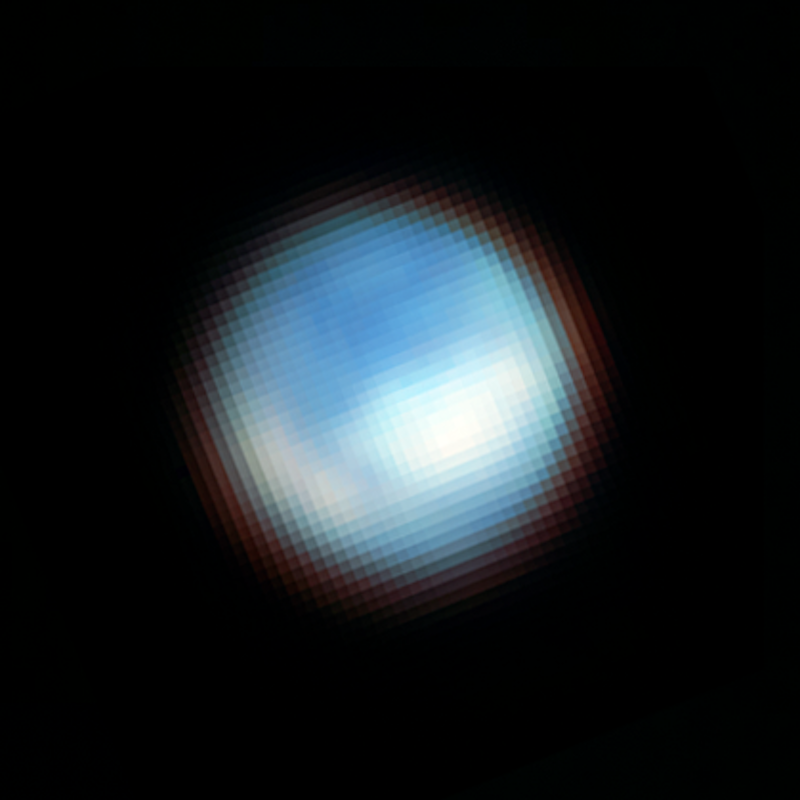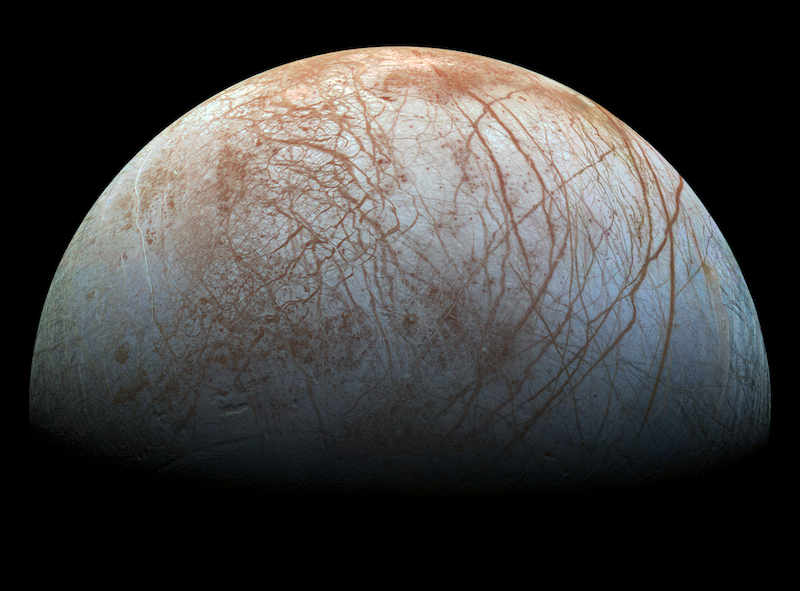
Jupiter’s moon Europa is thought to have a salty subsurface global ocean, topped with a thick layer of ice. Now, astronomers have identified carbon dioxide on the moon’s icy surface and found that it’s a relatively recent deposit. That’s important, because, as scientists have long said, carbon dioxide can be a life sign. On September 21, 2023, NASA announced two new studies suggesting the carbon dioxide on Europa’s surface came from deep in its ocean. If so, the finding would have significant implications for the question of life in Europa’s ocean.
The studies used new data from NASA’s James Webb Space Telescope. The American Association for the Advancement of Science (AAAS) also reported the discovery via EurekAlert!
The researchers published their two new peer-reviewed papers on September 21 in the journal Science. Read the first paper here and the second paper here.
Where did Europa’s carbon dioxide come from?
So how did the carbon dioxide on Europa’s surface get there? Did it originate directly from the ocean below or did meteorites deliver it directly to Europa’s surface?
Or – here’s another possibility – is it possible Jupiter’s mighty magnetic field interacted with chemicals on Europa’s surface in order to produce the carbon dioxide?
Scientists want to know the source because it can tell them a lot about what conditions are like in Europa’s subsurface ocean. Whether the carbon dioxide originated in the ocean or not can make a big difference in terms of that ocean’s chemistry and potential habitability, that is, its potential for developing and maintaining environments hospitable to extraterrestrial life.
Carbon is most likely from Europa’s ocean
Both of the studies used recent data from NASA’s James Webb Space Telescope. Webb analyzed the moon’s surface in near-infrared wavelengths. It mapped out the distribution of carbon dioxide ice and found that the highest concentration was in Tara Regio. That region is about 695 square miles (1,800 square km) and is dominated by what scientists call chaos terrain. In chaos terrain, surface materials show geological disruption and resurfacing. And there’s an exchange of material between the subsurface ocean and the icy surface. It’s some of the youngest terrain on Europa’s surface.
The analysis results suggest that the enriched levels of carbon dioxide in Tara Regio may mean that the carbon originated in Europa’s ocean. This is the endogenous scenario, where the carbon came from within Europa. The researchers said that the carbon came to the surface relatively recently on a geological timescale. In addition, this is also supported by the fact that carbon is unstable on Europa’s surface. So any deposits must be geologically young.
Samantha Trumbo of Cornell University, lead author of the 2nd paper, stated:
Previous observations from the Hubble Space Telescope show evidence for ocean-derived salt in Tara Regio. Now we’re seeing that carbon dioxide is heavily concentrated there as well. We think this implies that the carbon probably has its ultimate origin in the internal ocean.
Other carbonates or organics as a source
The researchers added, however, that it is still possible the formation of the carbon dioxide occurred on the surface itself, from carbonates or other organics. The 1st paper said:
A second potential source of CO2 could be carbonate-bearing fluids (e.g., sodium bicarbonate dissolved in water). Enceladus has a carbonate-rich ocean that degases CO2; some of that degassed CO2 freezes out on the surface. A similar process could occur on Europa.
A third possibility is that the carbon might be from organic compounds that were originally dissolved or suspended in a subsurface liquid-water reservoir, which were later converted to CO2. CO2 might be generated by irradiation on the surface, when material sourced from Europa’s interior, rich in carbonate salts and/or organics mixed with H2O, is bombarded by charged particles trapped in Jupiter’s magnetosphere.

External source of Europa’s carbon dioxide is unlikely
Significantly, the studies cast doubt on an exogenous – external – source of the carbon dioxide, such as meteorites. As the 1st paper notes:
Exogenous explanations for the observed CO2 on Europa are possible, but an exogenous source would likely produce a more global distribution, not the observed local concentration that is associated with salts (which are presumably endogenous). CO2 ice is also localized on Enceladus, where it is known to be endogenous. Exogenous interplanetary dust grains might deliver carbonaceous material to Europa’s icy surface, which could then yield CO2 through radiolysis, but no silicate features indicative of such exogenous material have been reported for Europa. Given the CO2 association with NaCl, and our laboratory results, we conclude that the most likely origin of the observed CO2 is endogenous, at least within Tara Regio.
Life in Europa’s ocean?
There is also, of course, the question of what originally produced the carbon dioxide if it does come from the ocean. Could it possibly be biological? Indeed, carbon is essential for life as we know it, and all life on Earth is carbon-based.
Unfortunately, as discussed in the 2nd paper, the researchers did analyze the isotopic ratio but couldn’t determine whether or not it was associated with life. But carbon in the ocean is still an encouraging sign for the possibility of life. Lead author of the first paper, Geronimo Villanueva of NASA’s Goddard Space Flight Center, said:
On Earth, life likes chemical diversity; the more diversity, the better. We’re carbon-based life. Understanding the chemistry of Europa’s ocean will help us determine whether it’s hostile to life as we know it, or if it might be a good place for life.
Trumbo added:
We now think that we have observational evidence that the carbon we see on Europa’s surface came from the ocean. That’s not a trivial thing. Carbon is a biologically essential element.
Previous studies have also supported the possibility that this alien ocean is habitable, by earthly standards.

No water plumes in new search
The researchers also looked for signs of Europa’s tentative water vapor plumes in the Webb data but didn’t see any. As has been surmised before, the plumes may be infrequent and smaller than those on Saturn’s moon Enceladus. It’s also possible that the plumes didn’t contain the volatile gases that the researchers included in their search. Heidi Hammel of the Association of Universities for Research in Astronomy (AURA) said:
There is always a possibility that these plumes are variable and that you can only see them at certain times. All we can say with 100% confidence is that we did not detect a plume at Europa when we made these observations with Webb.
The new results are not only exciting, but they also show how powerful and efficient Webb is. It only took Webb a few minutes to conduct these observations, as Hammel noted:
These observations only took a few minutes of the observatory’s time. Even with this short period of time, we were able to do really big science. This work gives a first hint of all the amazing solar system science we’ll be able to do with Webb.
Bottom line: Two new studies suggest that Europa’s carbon dioxide deposits originate in the moon’s subsurface ocean. The results support a habitable ocean environment.
Source: Endogenous CO2 ice mixture on the surface of Europa and no detection of plume activity
Source: The distribution of CO2 on Europa indicates an internal source of carbon











